Timelines and Charts
For example the following image is attributable to The National Museum of Natural History - Washington, D.C.
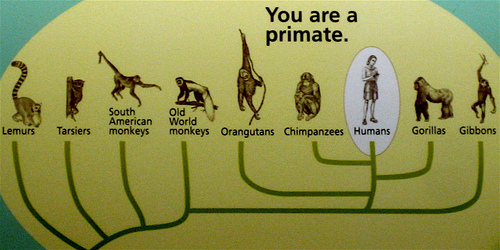
Science has come to accept that the evolution of Human Beings took place over many tens of millions of years.
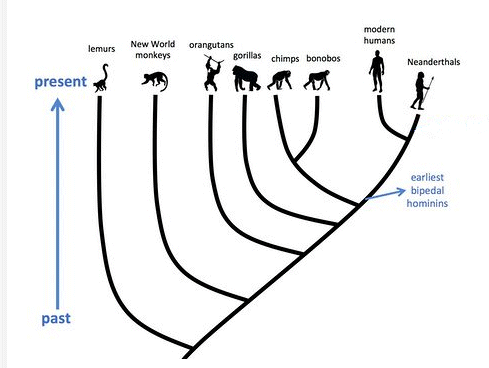
The extent of this timeline is such that the term "MYA" is used as shorthand for "Million Years Ago" when making reference to various stages on the Human Evolution Timeline and the term "YA" is similarly used for "Years Ago" when making references to more recent stages of this timeline.
55 MYA
First primitive primates appear as a result of even earlier and protracted processes of evolution.
8 - 6 MYA
First gorillas evolve. Later, chimp, bonobo and human lineages diverge from Gorilla-like ancestor species.
5.5 MYA
Ardipithecus, early "proto-human" shares traits with chimps and gorillas, and is forest-dwelling.
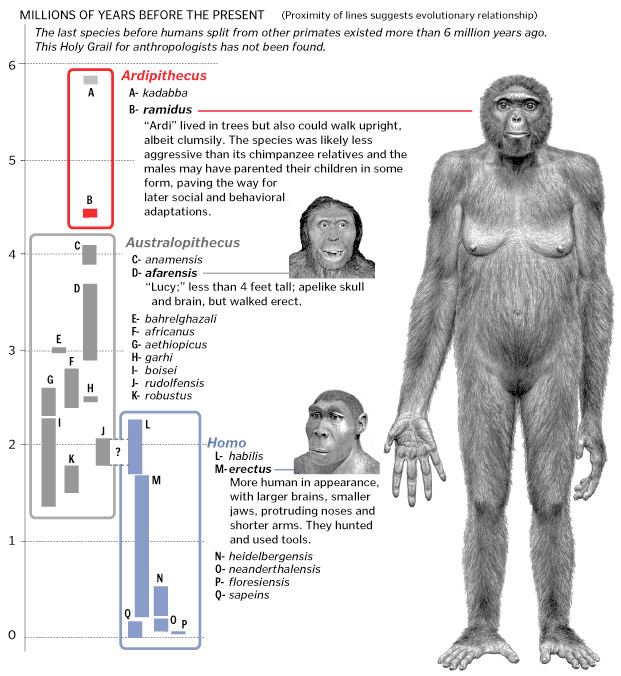
Ardipithecus Ramidus and the Human Evolution Timeline.
SOURCES: Science - AAAS, National Museum of Natural History's department of anthropology / Illustration by J.H. MATTERNES; Graphic by The Washington Post - Oct. 1, 2009
Modern Science has come to classify individually identifiable life-forms as being Species with such Species typically being members of a Genus of related species. A significant stage of
the Human Evolution Timeline was reached when the Genus Australopithecus emerged from previous types of primate life.
4 MYA
Australopithecines appear. They have brains no larger than a chimpanzee's - with a volume around 400 - 500 cm3. Australopithecenes are held to have been fairly capable of walking upright on two legs and are considered to have been amongst the earliest human ancestors to live on the savannah.
3.2 MYA
Lucy, famous specimen of Australopithecus afarensis, lives near what is now Hadar, Ethiopia.
Another highly significant stage of the Human Evolution Timeline is held to have been reached when the Genus Homo emerged from previous types of life. Homo Erectus (H. erectus) has become
recognised as being one of the earliest identifiable species within this emergent Genus.
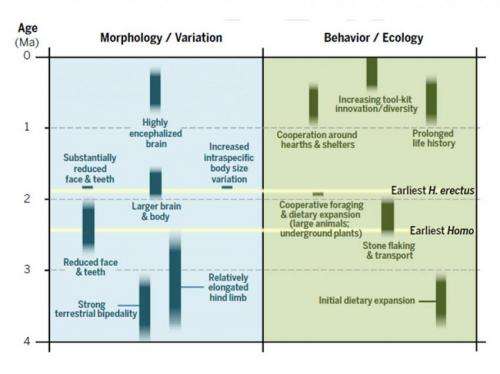
Evolutionary timeline chart of important anatomical, behavioral and life history characteristics that were once thought to be associated with the origin of the genus Homo or the earliest instances of Homo Erectus. Credit: Anton et al., Science 2014.
2.5 MYA
Homo habilis appears. Its face protrudes less than earlier hominids, but still retains many ape features. Has a brain volume of around 600 cm3.
Hominids start to use stone tools regularly, created by splitting pebbles - this starts Oldowan tradition of toolmaking, which last a million years.
Some hominids develop meat-rich diets as scavengers, the extra energy may have favoured the evolution of larger brains.
2 MYA
Evidence of Homo ergaster, with a brain volume of up to 850 cm3, in Africa.
1.8 - 1.5 MYA
Homo erectus is found in Asia. First true hunter-gatherer ancestor, and also first to have migrated out of Africa in large numbers. It attains a brain size of around 1000 cm3.
1.6 MYA
Possible first sporadic use of fire suggested by discoloured sediments in Koobi Fora, Kenya. More convincing evidence of charred wood and stone tools is found in Israel and dated to 780,000 years ago.
600,000 YA
Homo Heidelbergensis lives in Africa and Europe. Similar brain capacity to modern humans.
400,000 YA
Early humans begin to hunt with spears.
280,000 YA
First complex stone blades and grinding stones.
230,000 YA
Neanderthals appear and are found across Europe, from Britain in the west to Iran in the east, until they become extinct some 28,000 years ago.
195,000 YA
Our own species Homo sapiens appears on the scene - and shortly after begins to migrate across Asia and Europe. Oldest modern human remains are two skulls found in Ethiopia that date to this period. Average human brain volume is 1350 cm3.
170,000 YA
Mitochondrial Eve, the direct ancestor to all living people today, may have been living in Africa. Mitochondrial DNA is transmitted only through the female line and investigations appear to show that all modern people are descended from "Mitochondrial Eve".
50,000 YA
"Great leap forward": human culture starts to change much more rapidly than before; people begin burying their dead ritually; create clothes from animal hides; and develop complex hunting techniques, such as pit-traps.
10,000 YA
Agriculture develops and spread. First villages. Possible domestication of dogs.
5,500 YA
Stone Age ends and Bronze Age begins. Humans begin to smelt and work copper and tin, and use them in place of stone implements.
6,000 to 5,500 YA
The Sumerians of Mesopotamia develop the world's first civilisation.

Is Human Being more truly Metaphysical than Physical?
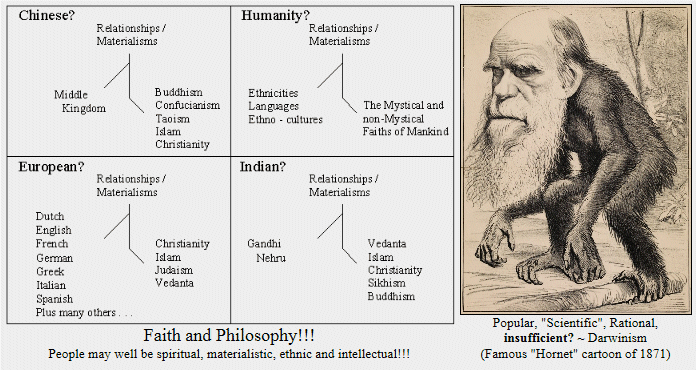
Ralph Waldo Emerson
RALPH WALDO EMERSON (1803-1882) was, in his time, the leading voice of intellectual culture in the United States. He remains widely influential to this day through his essays, lectures, poems, and philosophical writings.
In the later eighteen-twenties Ralph Waldo Emerson read, and was very significantly influenced by, a work by a French philosopher named Victor Cousin.
A key section of Cousin's work reads as follows:
"What is the business of history? What is the stuff of which it is made? Who is the personage of history? Man : evidently man and human nature.
There are many different elements in history. What are they? Evidently again, the elements of human nature. History is therefore the development of humanity,
and of humanity only; for nothing else but humanity develops itself, for nothing else than humanity is free. …
… Moreover, when we have all the elements, I mean all the essential elements, their mutual relations do, as it were, discover themselves. We draw from the nature of these different elements, if not all their possible relations, at least their general and fundamental relations."
Introduction to the History of Philosophy (1829)
… Moreover, when we have all the elements, I mean all the essential elements, their mutual relations do, as it were, discover themselves. We draw from the nature of these different elements, if not all their possible relations, at least their general and fundamental relations."
Introduction to the History of Philosophy (1829)
Even before he had first read Cousin, (in 1829), Emerson had expressed views in his private Journals which suggest that he accepted that Human Nature, and Human Beings, tend to display three identifiable aspects and orientations:
Imagine hope to be removed from the human breast & see how Society will sink, how the strong bands of order & improvement will be relaxed & what a deathlike stillness would take the place of the restless energies that now move the world. The scholar will extinguish his midnight lamp, the merchant will furl his white sails & bid them seek the deep no more. The anxious patriot who stood out for his country to the last & devised in the last beleagured citadel, profound schemes for its deliverance and aggrandizement, will sheathe his sword and blot his fame. Remove hope, & the world becomes a blank and rottenness.
(Journal entry made between October and December, 1823)
In all districts of all lands, in all the classes of communities thousands of minds are intently occupied, the merchant in his compting house, the mechanist over his plans, the statesman at his map, his treaty, & his tariff, the scholar in the skilful history & eloquence of antiquity, each stung to the quick with the desire of exalting himself to a hasty & yet unfound height above the level of his peers. Each is absorbed in the prospect of good accruing to himself but each is no less contributing to the utmost of his ability to fix & adorn human civilization. (Journal entry of December, 1824)
Our neighbours are occupied with employments of infinite diversity. Some are intent on commercial speculations; some engage warmly in political contention; some are found all day long at their books … (This dates from January - February, 1828)
In all districts of all lands, in all the classes of communities thousands of minds are intently occupied, the merchant in his compting house, the mechanist over his plans, the statesman at his map, his treaty, & his tariff, the scholar in the skilful history & eloquence of antiquity, each stung to the quick with the desire of exalting himself to a hasty & yet unfound height above the level of his peers. Each is absorbed in the prospect of good accruing to himself but each is no less contributing to the utmost of his ability to fix & adorn human civilization. (Journal entry of December, 1824)
Our neighbours are occupied with employments of infinite diversity. Some are intent on commercial speculations; some engage warmly in political contention; some are found all day long at their books … (This dates from January - February, 1828)
The quotes from Emerson are reminiscent of a line from another "leading voice of intellectual culture" - William Shakespeare.
There's neither honesty, manhood, nor good fellowship in thee.
William Shakespeare: Henry IV (Pt 1), Act I, Scene II
William Shakespeare: Henry IV (Pt 1), Act I, Scene II
Plato, Socrates and Shakespeare endorse a 'Tripartite Soul' view of Human Nature. Platos' Republic
